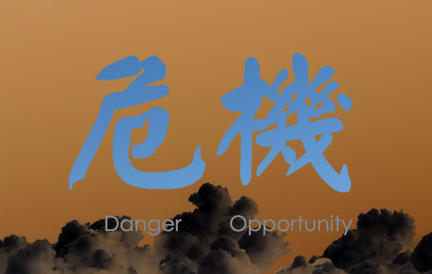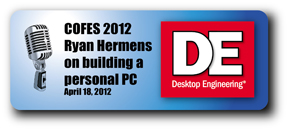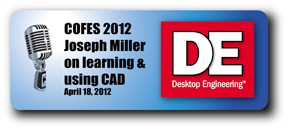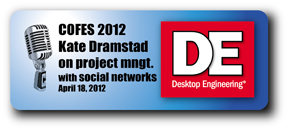Latest News
April 17, 2012
There was a cloud hanging over Scottsdale, Arizona, the site of the Congress on the Future of Engineering Software (COFES). It was not the rain clouds casting long shadows over the rugged mountains that served as the backdrop of the resort where attendees had gathered. It was Cloud with a capital C.
A network of interconnected computers, collectively forming the Cloud, is posing serious threats to the old ways. Would traditional client-server setups still be around five years from now? Would everyone be tossing aside shrink-wrapped software titles in favor of browser-based software? Would the Cloud inevitably become an extension of individual workstations? During Saturday evening’s symposium, these questions—and many more—echoed the anxiety (and the rise of blood pressure) brought on by Cloud Computing.
Organizers observed, “Our understanding of the Cloud today and the way it will change business, is similar to our understanding of the Internet back in 1996: It’s already affected us, we know it will change everything, but we are in for an interesting ride as the world is about to change in ways we just don’t get yet.”
Mike Payne, cofounder of SpaceClaim and CEO of Kenesto, observed, “Cloud is a platform, just like 32 bit Windows is.” One project manager in a large automotive manufacturing firm said, “We’re moving back to servers, bringing our stuff back in-house, because the Cloud hasn’t worked for us.” Another small business owner, who cited his ability to eliminate IT cost by moving to cloud-hosted IT, said, “It’s working for us.”
Randall Newton, managing editor of GraphicSpeak, added fuels to the inflamed conversation by pointing out, “Some businesses [which relied on the old ways of computing] will be forced to retire.”
With some untested technologies floating in the Cloud, with some vendors offering Cloud-hosted services without the backing of a history of success, the Cloud is, indeed, a potential risk. But it also promises relief in the form of lower IT maintenance costs, especially for small businesses that cannot afford their own hardware and computing architecture to support complex workflows. For CAD vendors who have traditionally thrived on selling professional software installation at roughly $5,000 a seat, the Cloud is a reason to be nervous. What will happen when users get a taste of mobile CAD, delivered in the form of SaaS (software as a service) or iPad apps?
Through Twitter, I sent my hypothetical question: What is the risk of not taking risk? Steve Bodnar, Autodesk’s VP of PLM and PDM, responded, “No risk = no reward.” Oleg Shilovitsky, cofounder of Inforbix, responded, “[That is the ] same as to decide NOT to decide.” Several Twitter users in the room also cited Dick Morley, member of the COFES board of directors, in their responses. Apparently Morley had said earlier that “not taking a risk is to 100% guarantee failure.”
The Chinese character for Risk, someone pointed out, is formed by combining the words for Danger and Opportunity. The Cloud is usually a harbinger of rain and wind, but also of sunnier days afterward. But surviving the rainy days could prove tricky for some.
Future CAD and PLM Users, in Their Own Words
COFES, explained cofounder Brad Holtz from Cyon Research, “is all about the conversations and networking that take place in the hallways and corridors.”
He’s right about that. I discovered it’s much easier to catch the next generation of engineers and designers—the people who will determine the fate of CAD, PDM (product data management), and PLM (product lifecycle management)—outside the meeting rooms than inside.
Ryan Hermens, a FIRST intern, was keeping a close watch on the audio equipment at COFES. Ryan, a high school senior, may quite possibly be the youngest COFES attendee. An aspiring computer scientist, he built his own computer, connected to a trio of monitors via AMD’s EyeFinity technology. (”[It’s] my favorite thing besides my girlfriend,” he confessed.)
He upgrades his machine on a two-year cycle, adding new processors and hard drives as his needs grow. For him, professional benchmarks and his own personal benchmark—how the machine performs when playing Battlefield III—are equally important. He cannot afford to have one machine for multimedia entertainment, another for engineering work; therefore, he must have one that satisfies both.
Joseph Miller, another COFES intern, who hopes to transfer to Virginia Tech in the fall, is studying mechanical and electrical engineering as his dual major. His first exposure to 3D modeling came from Google SketchUp. Since then he has mastered Autodesk Inventor, AutoCAD, SolidWorks, and Pro/ENGINEER.
“I’m a student, so I am driven by what [software] I can get for free,” he said. Both Joseph and Ryan rely on reviews posted by users at Newegg.com (tech geek’s equivalent to Amazon.com) in addition to reviews published in traditional magazines. Both Ryan and Joseph reinforced vendors’ theory that giving away free or low-cost education licenses can help build brand loyalty.
Kate Dramstad, a software engineering student from Olin College of Engineering, gave a presentation on building an affordable cassava grading system for the locals in Ghana, a project she undertook as part her coursework on Affordable Design and Entrepreneurship. Cobbling together Facebook and Dropbox, she and her team came up with their own homegrown project management system, accessible from everywhere over the web.
The Facebook Group used by the team, Kate explained, is not for sharing design prototypes but for fostering community and connectivity among her team, scattered around the world from the U.S. to Ghana. “It’s for us the virtual water cooler, where we can come together and share stories,” she said. The appeal of familiar social networks and file-sharing portals like Facebook and Dropbox, she revealed, was “There are tools we’re already using. They integrate very well into our day to day.”
Contrary to the secretive concept-development practices prevalent in design and engineering projects, Kate is glad to see “copycat” projects sprouting up. “We spent a lot of time developing solutions that are going to change people’s lives. If they are so attractive that others are copying them, that means we’re impacting more people,” she said.
The Cloud represents a new way of accomplishing computing operations. Preferences for social network-driven knowledge, Facebook-centric projects, do-it-yourself mentality, and open-source IP among Ryan, Joseph, and Kate represent new ways of thinking about design and engineering. To the delight of many and the distress of some, they are quite literally agents of change, bringing both risk and opportunity for established technology titans.
For more, listen to the interviews with Ryan Hermens, Joseph Miller, and Kate Dramstad, posted below as podcasts:
Subscribe to our FREE magazine, FREE email newsletters or both!
Latest News
About the Author
Kenneth Wong is Digital Engineering’s resident blogger and senior editor. Email him at [email protected] or share your thoughts on this article at digitaleng.news/facebook.
Follow DE









